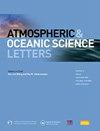Statistical seasonal forecasting of tropical cyclone landfalls on Taiwan Island
IF 3.2
4区 地球科学
Q3 METEOROLOGY & ATMOSPHERIC SCIENCES
引用次数: 0
Abstract
Forecasting tropical cyclone (TC) activities has been a topic of great interest and research. Taiwan Island (TW) is one of the key regions that is highly exposed to TCs originated from the western North Pacific. Here, the authors utilize two mainstream reanalysis datasets for the period 1979–2013 and propose an effective statistical seasonal forecasting model—namely, the Sun Yat-sen University (SYSU) Model—for predicting the number of TC landfalls on TW based on the environmental factors in the preseason. The comprehensive predictor sampling and multiple linear regression show that the 850-hPa meridional wind over the west of the Antarctic Peninsula in January, the 300-hPa specific humidity over the open ocean southwest of Australia in January, the 300-hPa relative vorticity over the west of the Sea of Okhotsk in March, and the sea surface temperature in the South Indian Ocean in April, are the most significant predictors. The correlation coefficient between the modeled results and observations reaches 0.87. The model is validated by the leave-one-out and nine-fold cross-validation methods, and recent 9-yr observations (2014–2022). The Antarctic Oscillation, variabilities of the western Pacific subtropical high, Asian summer monsoon, and oceanic tunnel are the possible physical linkages or mechanisms behind the model result. The SYSU Model exhibits a 98% hit rate in 1979–2022 (43 out of 44), suggesting an operational potential in the seasonal forecasting of TC landfalls on TW.
摘要
本文利用1979–2013年的两个主流再分析数据集, 提出了一个中山大学 (SYSU) 热带气旋统计季节预报模型, 基于4个季前环境因子对登陆台湾岛的热带气旋数量进行预报. 模型通过了留一法, 九折交叉验证法和近9年观测数据 (2014–2022) 的验证, 模型结果与实际观测的相关系数达0.87. 南极涛动, 西太平洋副热带高压变化, 亚洲夏季风和海洋通道是模型潜在的物理联系或机制. SYSU模型在1979–2022年期间的预报准确率为98%, 表现出其业务应用价值.

热带气旋登陆台湾的季节统计预报
热带气旋活动预报一直是一个备受关注和研究的课题。台湾岛是北太平洋西部tc高暴露的重点地区之一。本文利用1979-2013年两个主流的再分析数据集,提出了一种有效的基于季前环境因子的季节预报模型——中山大学(SYSU)模型。综合预报采样和多元线性回归结果表明,1月南极半岛西部850 hpa经向风、1月澳大利亚西南公海300 hpa比湿度、3月鄂霍次克海西部300 hpa相对涡度和4月南印度洋海温是最显著的预报因子。模拟结果与观测值的相关系数达到0.87。该模型通过留一法和九倍交叉验证方法以及最近9年的观测(2014-2022)进行了验证。南极涛动、西太平洋副热带高压变率、亚洲夏季风和海洋隧道是模式结果背后可能的物理联系或机制。SYSU模型在1979-2022年的准确率为98%(44个中的43个),表明在TW上的TC登陆的季节性预测中具有操作潜力。摘要本文利用1979 - 2013年的两个主流再分析数据集,提出了一个中山大学(于中山)热带气旋统计季节预报模型,基于4个季前环境因子对登陆台湾岛的热带气旋数量进行预报。模型通过了留一法,九折交叉验证法和近9年观测数据(2014 - 2022)的验证,模型结果与实际观测的相关系数达0.87。南极涛动, 西太平洋副热带高压变化, 亚洲夏季风和海洋通道是模型潜在的物理联系或机制. Sysu (Sysu), 1979-2022,中国科学院院士,中国科学院院士,中国科学院院士。
本文章由计算机程序翻译,如有差异,请以英文原文为准。
求助全文
约1分钟内获得全文
求助全文
来源期刊

Atmospheric and Oceanic Science Letters
METEOROLOGY & ATMOSPHERIC SCIENCES-
CiteScore
4.20
自引率
8.70%
发文量
925
审稿时长
12 weeks
 求助内容:
求助内容: 应助结果提醒方式:
应助结果提醒方式:


